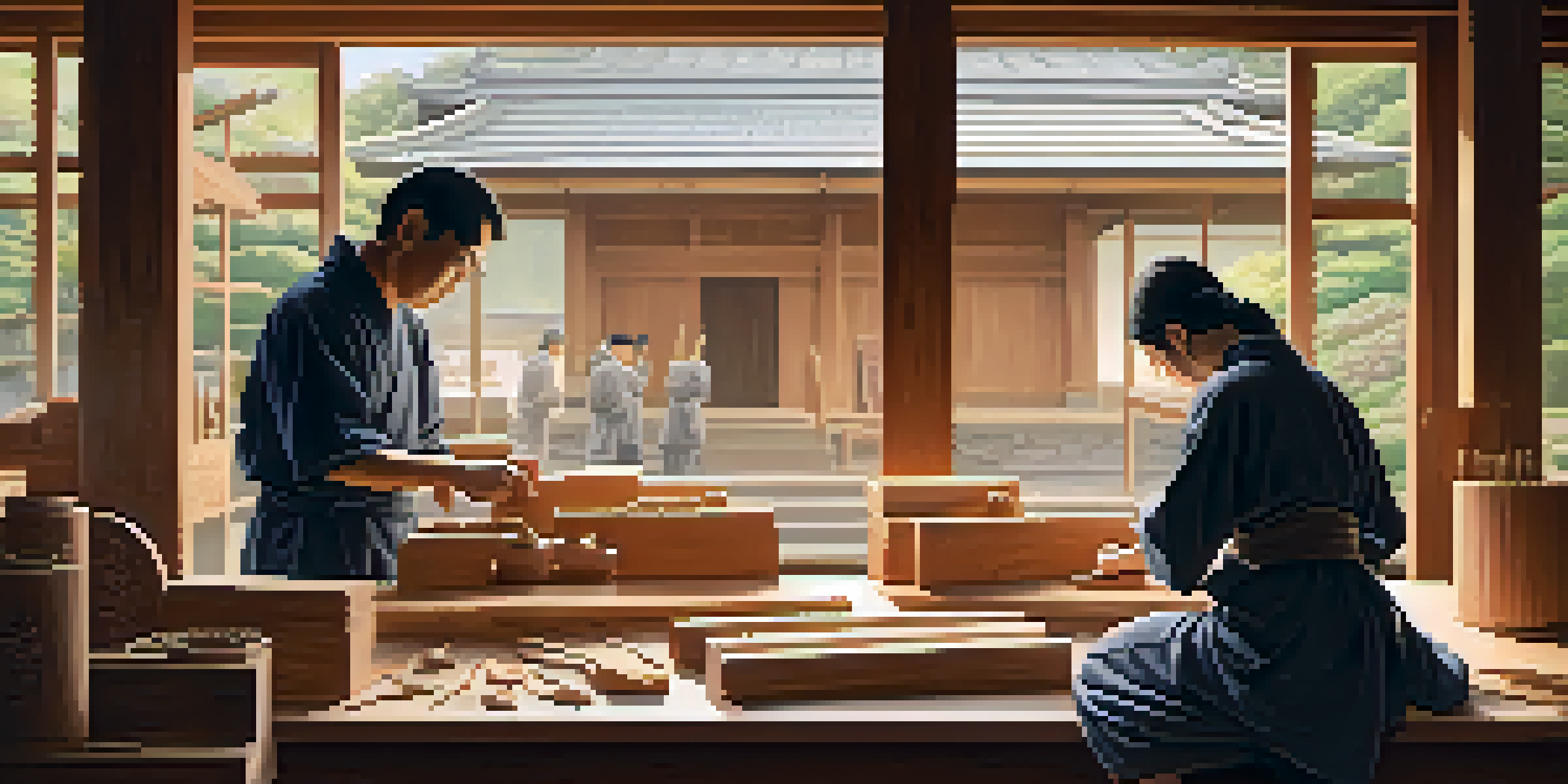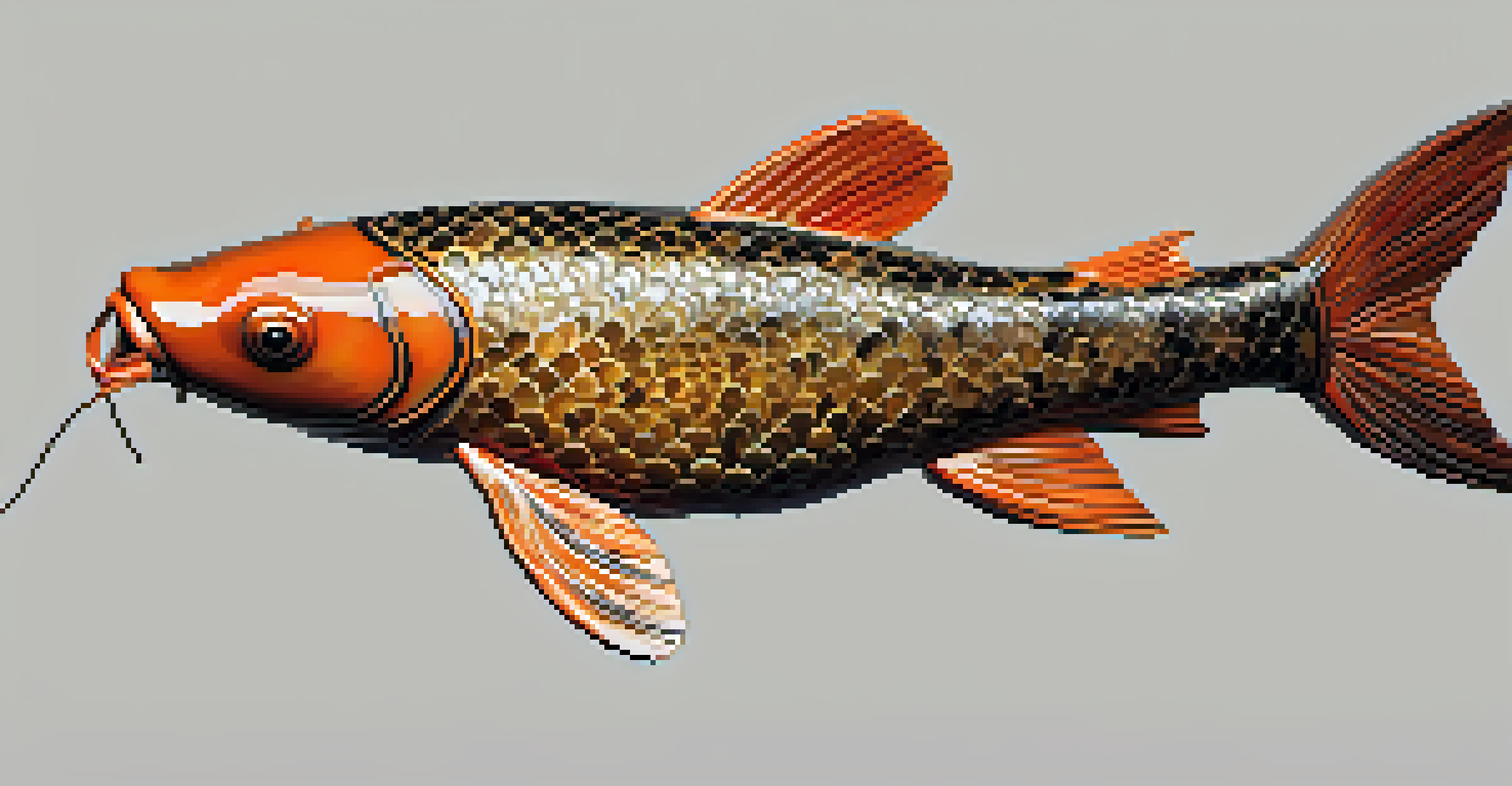The Influence of Japanese Aesthetic in Wood Carving Techniques

Understanding Japanese Aesthetics in Art
Japanese aesthetics are deeply rooted in concepts like simplicity, nature, and imperfection. These principles encourage a deep appreciation for the beauty found in everyday life. For instance, the idea of 'wabi-sabi' celebrates the beauty of things that are imperfect, impermanent, and incomplete, which resonates strongly in various art forms, including wood carving.
In every work of art, there is a story waiting to be told, and the beauty of wood carving is that it embodies both the artist's vision and the cultural heritage it represents.
In wood carving, this aesthetic translates into designs that emphasize organic shapes and natural textures. Carvers often seek to preserve the wood's original character, allowing the grain and knots to enhance the final piece. This approach not only respects the material but also connects the artist with nature, imparting a sense of harmony.
By understanding these aesthetic values, artists can create works that resonate on a deeper level with viewers. This connection enriches the experience of the art, making it more than just a visual object; it becomes a reflection of cultural values and philosophies.
Traditional Japanese Wood Carving Techniques
Japanese wood carving boasts a rich history, with techniques passed down through generations. One of the most notable styles is 'mokuhanga,' or woodblock printing, which involves carving images into wooden blocks. This method highlights the intricate details and textures that define traditional Japanese art, showcasing the skill and patience of the artists.

Carvers often use a variety of tools, including chisels and knives, to achieve different effects. The precision required in these techniques reflects the discipline inherent in Japanese culture. Each cut is deliberate, aiming to highlight the wood's natural beauty while creating a harmonious composition.
Japanese Aesthetics Emphasize Nature
Japanese aesthetics prioritize simplicity, nature, and imperfection, as seen in the practice of 'wabi-sabi,' which celebrates the beauty in everyday life.
These traditional methods not only produce stunning artworks but also serve as a way to preserve cultural heritage. They remind us of the importance of craftsmanship and the stories behind each piece, connecting the past with the present in a tangible form.
The Role of Nature in Japanese Wood Carving
Nature plays a pivotal role in Japanese wood carving, influencing both the materials used and the designs created. Artists often select wood from local trees, such as cherry or cedar, which not only reflects the region's natural beauty but also embodies a sense of place. This connection to nature is vital, as it informs the aesthetics and philosophy of the artwork.
Art is not what you see, but what you make others see.
The designs often mimic natural forms, such as waves, leaves, and animals, creating a sense of harmony between the artwork and its environment. This mimetic quality echoes the Japanese belief that nature and art are intertwined, fostering a sense of tranquility and balance in both the artist's process and the viewer's experience.
Additionally, the choice of wood can evoke different emotions and meanings, further deepening the connection to nature. For example, the warm tones of cherry wood might evoke feelings of nostalgia, while the cool hues of cedar might inspire a sense of calm. This interplay enriches the overall experience of the artwork.
Symbolism in Japanese Wood Carving
Symbolism is a crucial aspect of Japanese wood carving, often embedded in the designs themselves. Many carvings feature motifs that carry specific meanings, such as cranes for longevity and pine trees for resilience. These symbols not only beautify the piece but also convey messages and stories, connecting the artwork to cultural traditions.
The use of symbolism allows artists to communicate complex ideas and emotions in a subtle yet powerful way. For instance, a carving depicting a koi fish might symbolize perseverance and strength, reflecting the cultural belief in overcoming adversity. This depth of meaning invites viewers to engage with the artwork on multiple levels.
Symbolism Enriches Wood Carving
Symbolism plays a crucial role in Japanese wood carving, with motifs like cranes and koi fish conveying deep cultural meanings and stories.
Moreover, the incorporation of these symbols enriches the viewer’s experience, prompting reflection and interpretation. As people connect with the meanings behind the carvings, they create a personal bond with the artwork, making it more than just a decorative object; it becomes a vessel of cultural storytelling.
Modern Interpretations of Traditional Techniques
While traditional techniques form the backbone of Japanese wood carving, modern artists are reinterpreting these methods to create contemporary works. Many carvers blend traditional aesthetics with innovative designs, resulting in pieces that resonate with both historical significance and modern sensibilities. This fusion breathes new life into age-old practices, making them relevant for today's audiences.
For example, some artists are experimenting with mixed media, combining wood with materials like metal or glass. This approach not only enhances the visual appeal but also challenges the conventional boundaries of wood carving. As a result, new narratives emerge, reflecting the complexities of modern life while honoring traditional roots.
These modern interpretations also encourage dialogue about the evolution of craftsmanship and the role of tradition in contemporary art. By pushing the boundaries of what wood carving can be, artists invite viewers to appreciate the ongoing relevance of these techniques in our ever-changing world.
Cultural Preservation through Wood Carving
Wood carving is more than an art form; it is a means of preserving cultural heritage in Japan. As traditional techniques face the threat of fading away, many artisans are dedicated to keeping these practices alive. By teaching the next generation, they ensure that the rich history of Japanese wood carving continues to thrive, fostering a sense of identity and pride.
Workshops and community programs play a vital role in this cultural preservation, offering hands-on experiences for people of all ages. These initiatives not only teach the skills involved in wood carving but also instill an appreciation for the artistry and philosophy behind the craft. Participants often leave with a newfound respect for the tradition and a desire to carry it forward.
Modern Artists Revive Traditional Techniques
Contemporary artists are blending traditional Japanese wood carving techniques with innovative designs, creating works that resonate with both historical significance and modern sensibilities.
Moreover, the revitalization of interest in traditional crafts sparks a broader conversation about sustainability and the importance of preserving cultural narratives. As artisans create works that honor their heritage, they contribute to a growing movement that values the intersection of art, culture, and environmental stewardship.
The Global Influence of Japanese Wood Carving
The influence of Japanese wood carving extends far beyond its borders, inspiring artists worldwide. The principles of simplicity, nature, and craftsmanship resonate with a global audience, encouraging a deeper appreciation for the beauty of wood as a medium. Many contemporary artists draw from these concepts, integrating them into their own practices and creating a cross-cultural dialogue.
Exhibitions and collaborations have helped to showcase the unique qualities of Japanese wood carving on an international stage. Through these platforms, artists share their techniques and philosophies, fostering connections between diverse cultures and artistic expressions. This exchange enriches the global art community and encourages a greater understanding of the significance of wood carving.

As a result, Japanese wood carving continues to evolve, influenced by both tradition and the myriad perspectives of artists around the world. This dynamic interplay between cultures not only breathes new life into the art form but also emphasizes the universal nature of creativity and the shared human experience.